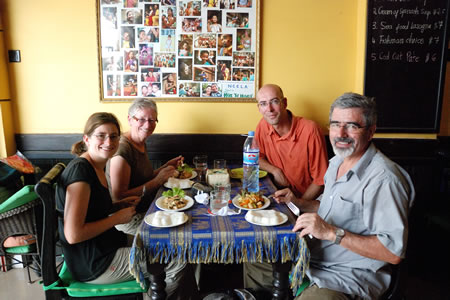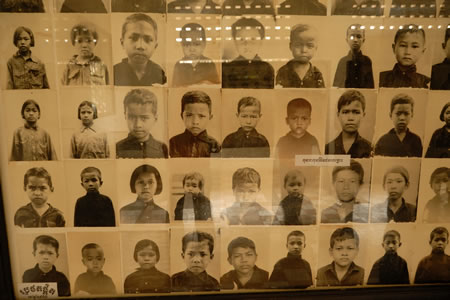

| Phnom Penh | |
Kampong Thom (Cambodia), February 7th 2009 |
|
This article is written by Jan, the father of Ivonne After a long flight from Germany to Bangkok, we picked up by Edwin and Ivonne at the airport. After a day of acclimatising in Bangkok, we left for the small tropical island of Ko Wai, near the Cambodian border. We enjoyed the island especially for it scenery, birding and especially the snorkelling, something we never did before. It is really great to swim between the tropical fish. Great! After Ko Wai we crossed the border to Cambodia and brought a visit to the Cardamom Mountains (see also the article and photo impression about the Cardamom Mountains). After visiting this area we took the bus to Phnom Penh, the capital city of Cambodia with more than 2 million people. For us, it was a relief if you compare it with Bangkok. It was also very nice to meet the Cambodian people. Of course, the Thai were also friendly, but the Cambodians have something special. The traffic in Phnom Penh is a chaos. It is not the right of the strongest, but the right of the bravest. To survive in the traffic of Phnom Penh you do not only need two angels on your shoulders, but also a couple in your pockets. You see all kind of vehicles in the city. From beautiful new cars, to hundreds or thousands of motorcycles. If you also add the many bicycle and motor-rickshaws, you know that it is a recipe of chaos. |
|
 |
|
Tasty lunch in the centre of Phnom Penh |
|
It is not easy to navigate through the city as pedestrian. Sidewalks are often occupied by street stalls, so you have to walk on the streets. The food in the street stalls is prepared on the spot, including the flies that are on it. You see also piles of chickens that are kept under control by binding their legs together. These chickens that lay in the sun all day, probably hope on a buyer soon who can free them from their suffering by chopping their heads off. We also went to the large central market that was under reconstruction during our visit. This large market is built in 1937 by the French in colonial style, and has the third largest dome of the world. When the market is operational, you can find more than 2000 stalls in it. The next day, we went early in the morning to the Toal Sleng museum, also often called the S21 building. It is the former interrogation and torture prison of the Khmer Rouge regime. What here happened is indescribable, and is one of the darkest chapters of Cambodian history. The building is built by the French as a school, but got a different function during the time of the Khmer Rouge. Between April 1975 and January 1979, more than 15,000 people were captured here, interrogated, tortured and finally killed at the extermination camp Choeung Ek (also known as the Killing Fields), a little bit out of town. It was a coincidence that during our visit to the prison, one of the seven survivors of the camp was interviewed on the spot, for a documentary. It was impressive to see. It must have been hard for him to be back in the prison and to tell the film makers about what happened in that prison. Once in a while he couldn’t control his emotions and tears were rolling over his cheeks. Everywhere are sign asking you to be quiet. But the signs are not necessary, because what you see makes you silent. In one of the buildings you can still see how the different rooms were used as interrogation and torture room. You still see the beds on at which the prisoners were chained. In another building you can see the small cells of 0.8 by 2.0 metres in where the prisoners lived and many pictures of the victims. For some reason the Khmer Rouges administers all their crimes in detail. It is also possible to see many paintings of the torture activities. The paintings are made by one of the survivors. He made these paintings in assignment of the Khmer Rouge regime and by doing it, he saved his life. |
|
 |
|
Some of the victims (children) of the Khmer Rouge regime |
|
| In the afternoon we went to the “Wat Phnom” temple. It is a holy place for the Cambodian people. Not only the gods and spirits are worshipped on this hill, but also the founder of the city, Ms Penh. The story goes that she found a floating trunk in the Mekong River, on where stood four bronze statues. To bring them to a place of safety, she constructed this hill (= Phnom) and built a stupa on it. The name of the city is named after this hill: Phnom Penh.
The next day we went to the Royal Palace with the Silver Pagoda. This pagoda is not the oldest one, but it is definitely the most luxurious. The floor is tiled with 5,000 silver tiles that have a weight of one kilogram each. French lilies are carved in the tiles. In the pagoda you will find a emerald Buddha (a copy) and a gold Buddha. The last one has a weight of 90 kilograms and is decorated with 2086 diamonds, of which the largest is 25 carats. Outside you will see the Sala-tree (a holy tree), a tree with the leaves in the top and beautiful flowers in the lower region of the tree, which spring directly from the trunk. In the evening we went to the Russian market. It was amazing. It is incredible to see what you can buy over there. Everything is available, from silver and gold jewellery, textiles in all colours and measures to all spare parts of motorcycles. As often, our favourite section was the section where the food is prepared and where you can find the colourful food. Finally we want to say that we really enjoyed Phnom Penh. It is a very atmospheric city where it is still possible to see and experience the real Asia. The city is absolutely recommended! © copyright - Babakoto.eu / 2009 |
|